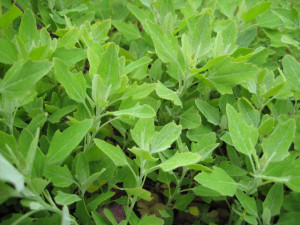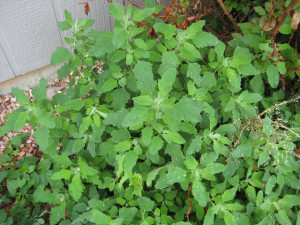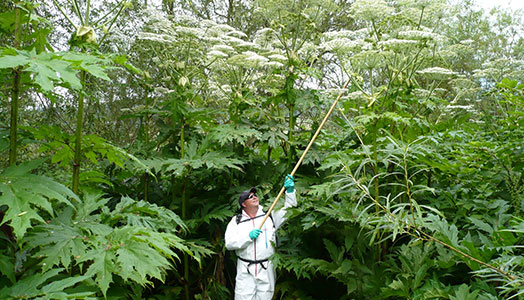Wild Foraging - Goosefoot/lamb's quarters
Sep. 13th, 2018 09:05 amGoosefoot, aka lamb’s quarters, wild spinach, and pigweed,

https://wildfoodgirl.com/2010/goosefoot/
“It tastes like its relative, spinach …only better,” Brill writes in Identifying and Harvesting Edible and Medicinal Plants. “However, it shrinks by about two thirds when you cook it, so be sure to collect enough.”
High-protein lamb's quarters seeds can be used to make flour and bread.
Forage for goosefoot in the flower beds, snipping the tops and individual leaves off tall plants and taking the small plants (8 inches in height or less) in their entirety.
Then meticulously wash and trim leaves and stems.
A dashed of olive oil, salt the leaves lightly, and cook for a couple of minutes until the leaves wilted before adding a cup of water, covering, steaming for 7 minutes, draining, and sprinkling with soy sauce. What started out as about 8 cups of plant parts cooked down to about 2 cups.
Seeds
Let some of your goosefoot go to seed & you have great quinoa! The plants share the same family & the seeds can be prepared exactly the same way. Rub dried seed heads between palms to loosen outer hulls. Either in front of a fan on very low (outdoors) or when it’s mildly windy is the best for winnowing. A clean old sheet is the best. Just have two people gently toss them until as clean as possible. They can be picked over then to finish.
Anything you do with quinoa is doable with goosefoot seed.
One thing a good overnight soak and rub reduces the bitterness by removing the saponin layer.
Chenopodium album is the most abundant, and also the one to which the monikers “lamb’s quarter” and “goosefoot” are applied. There is a distinction between the two common names,the also-edible eastern variety, C. hybridium or C. simplex, aka “maple-leaved goosefoot,” has larger, darker leaves than lamb’s quarters.
An acre requires approximately a pound of seed. Ten plants will yield roughly 1 pound of grain, depending on your growing conditions. Plant enthusiasts may have noticed the similarity between Quinoa and Amaranth. Lamb's Quarters is known as wild Quinoa

http://www.gracelinks.org/blog/4255/real-food-right-now-and-how-to-cook-it-lamb-s-quarters
Lamb's quarters plants can get quite large - as tall as seven feet - and generally have deep-green leaves shaped (supposedly) like a goose's foot. (There are also varietals that have a bit of pink or red on the young leaves and stems.) Younger leaves have a white, powdery substance on the underside that is perfectly normal. Look for younger leaves if you want to eat the plant raw, as older leaves can get a bit tough. At the farmers' market, seek out lamb's quarters that are perky (they wilt easily), with no drying or yellow leaves. When foraging, as always, the golden rule is to first be completely sure that what you are picking is edible, because there are several non-edible lamb's quarters look-alikes. Here's Wildman Steve Brill's post on how to identify the plant, and here's a video that demonstrates foraging for the veggie. It is also worth noting that you must be careful where you forage, to ensure that your lamb's quarters have not been sprayed with herbicides.
Like other so-called "weeds" (see our recent article on purslane), lamb's quarters is incredibly nutritious. It is high in fiber, protein and is loaded with both Vitamins A and C. The plant is also high in manganese, calcium, copper and has a bit of iron, and is high in both Omega-3 and Omega-6 fatty acids. Like spinach and other greens, it does contain quite a bit of oxalic acid, which can be both a stomach irritant and can impede the absorption of calcium. Cooking lamb's quarters eliminates most oxalic acid - but go easy if you choose to eat it raw. And like quinoa, the seeds and leaves contain saponin, which can also be a stomach irritant. Saponin can be ameliorated by rinsing the seeds well, and by cooking the leaves.
Lamb's quarters leaves can be eaten both raw and cooked (but see our note in "Nutrition," above, about oxalic acid and saponins in the raw plant). Give the leaves a good rinse before eating to get rid of the (normal) white, powdery bloom on them. If cooking, the veggie fares better when it is quickly sautéed or steamed; its delicate leaves tend to disintegrate if cooked for a long period of time. Like spinach, it pares well with alliums (think onions and garlic), with cream (as in this cream of lamb's quarters soup) with cheese (especially hard cheeses like Parmesan) and with citrus (think lemon and orange). Here is a nice recipe roundup of ideas* on how to cook lamb's quarters, including a green smoothie made with the veggie, lamb's quarters salad and lamb's quarters with beans.
Freezing for later
http://www.theselfsufficienthomeacre.com/2014/06/freezing-lambs-quarters.html
Pick lambs quarters when they are young and tender for the best results.
Morning is the best time to harvest when the temps are cooler. Soak the greens in cool water for a few minutes and rinse away the dirt.
Blanch the greens in boiling water just until the color changes to a deep green and the leaves are limp.
Remove the blanched greens from the pot, drain, and cool in a shallow pan in your refrigerator.
When they are completely cooled, pack them into freezer containers or bags, removing as much air as you can to prevent freezer burn.
Pack enough in each bag for one or two meals. Don’t be tempted to save time and bags by packing a huge gallon size bag if you won’t be able to use it all at one time. It is nearly impossible to break up a huge chunk of frozen greens.
You may also freeze the greens in a shallow pan before packing them into a bag. This way you can pack the frozen greens loosely in bags that can be opened and only partially used.
Use your frozen lambs quarters within a year for the best flavor and nutritional value.
*http://laist.com/2012/02/14/seasonal_eats_1.php

https://wildfoodgirl.com/2010/goosefoot/
“It tastes like its relative, spinach …only better,” Brill writes in Identifying and Harvesting Edible and Medicinal Plants. “However, it shrinks by about two thirds when you cook it, so be sure to collect enough.”
High-protein lamb's quarters seeds can be used to make flour and bread.
Forage for goosefoot in the flower beds, snipping the tops and individual leaves off tall plants and taking the small plants (8 inches in height or less) in their entirety.
Then meticulously wash and trim leaves and stems.
A dashed of olive oil, salt the leaves lightly, and cook for a couple of minutes until the leaves wilted before adding a cup of water, covering, steaming for 7 minutes, draining, and sprinkling with soy sauce. What started out as about 8 cups of plant parts cooked down to about 2 cups.
Seeds
Let some of your goosefoot go to seed & you have great quinoa! The plants share the same family & the seeds can be prepared exactly the same way. Rub dried seed heads between palms to loosen outer hulls. Either in front of a fan on very low (outdoors) or when it’s mildly windy is the best for winnowing. A clean old sheet is the best. Just have two people gently toss them until as clean as possible. They can be picked over then to finish.
Anything you do with quinoa is doable with goosefoot seed.
One thing a good overnight soak and rub reduces the bitterness by removing the saponin layer.
Chenopodium album is the most abundant, and also the one to which the monikers “lamb’s quarter” and “goosefoot” are applied. There is a distinction between the two common names,the also-edible eastern variety, C. hybridium or C. simplex, aka “maple-leaved goosefoot,” has larger, darker leaves than lamb’s quarters.
An acre requires approximately a pound of seed. Ten plants will yield roughly 1 pound of grain, depending on your growing conditions. Plant enthusiasts may have noticed the similarity between Quinoa and Amaranth. Lamb's Quarters is known as wild Quinoa

http://www.gracelinks.org/blog/4255/real-food-right-now-and-how-to-cook-it-lamb-s-quarters
Lamb's quarters plants can get quite large - as tall as seven feet - and generally have deep-green leaves shaped (supposedly) like a goose's foot. (There are also varietals that have a bit of pink or red on the young leaves and stems.) Younger leaves have a white, powdery substance on the underside that is perfectly normal. Look for younger leaves if you want to eat the plant raw, as older leaves can get a bit tough. At the farmers' market, seek out lamb's quarters that are perky (they wilt easily), with no drying or yellow leaves. When foraging, as always, the golden rule is to first be completely sure that what you are picking is edible, because there are several non-edible lamb's quarters look-alikes. Here's Wildman Steve Brill's post on how to identify the plant, and here's a video that demonstrates foraging for the veggie. It is also worth noting that you must be careful where you forage, to ensure that your lamb's quarters have not been sprayed with herbicides.
Like other so-called "weeds" (see our recent article on purslane), lamb's quarters is incredibly nutritious. It is high in fiber, protein and is loaded with both Vitamins A and C. The plant is also high in manganese, calcium, copper and has a bit of iron, and is high in both Omega-3 and Omega-6 fatty acids. Like spinach and other greens, it does contain quite a bit of oxalic acid, which can be both a stomach irritant and can impede the absorption of calcium. Cooking lamb's quarters eliminates most oxalic acid - but go easy if you choose to eat it raw. And like quinoa, the seeds and leaves contain saponin, which can also be a stomach irritant. Saponin can be ameliorated by rinsing the seeds well, and by cooking the leaves.
Lamb's quarters leaves can be eaten both raw and cooked (but see our note in "Nutrition," above, about oxalic acid and saponins in the raw plant). Give the leaves a good rinse before eating to get rid of the (normal) white, powdery bloom on them. If cooking, the veggie fares better when it is quickly sautéed or steamed; its delicate leaves tend to disintegrate if cooked for a long period of time. Like spinach, it pares well with alliums (think onions and garlic), with cream (as in this cream of lamb's quarters soup) with cheese (especially hard cheeses like Parmesan) and with citrus (think lemon and orange). Here is a nice recipe roundup of ideas* on how to cook lamb's quarters, including a green smoothie made with the veggie, lamb's quarters salad and lamb's quarters with beans.
Freezing for later
http://www.theselfsufficienthomeacre.com/2014/06/freezing-lambs-quarters.html
Pick lambs quarters when they are young and tender for the best results.
Morning is the best time to harvest when the temps are cooler. Soak the greens in cool water for a few minutes and rinse away the dirt.
Blanch the greens in boiling water just until the color changes to a deep green and the leaves are limp.
Remove the blanched greens from the pot, drain, and cool in a shallow pan in your refrigerator.
When they are completely cooled, pack them into freezer containers or bags, removing as much air as you can to prevent freezer burn.
Pack enough in each bag for one or two meals. Don’t be tempted to save time and bags by packing a huge gallon size bag if you won’t be able to use it all at one time. It is nearly impossible to break up a huge chunk of frozen greens.
You may also freeze the greens in a shallow pan before packing them into a bag. This way you can pack the frozen greens loosely in bags that can be opened and only partially used.
Use your frozen lambs quarters within a year for the best flavor and nutritional value.
*http://laist.com/2012/02/14/seasonal_eats_1.php









